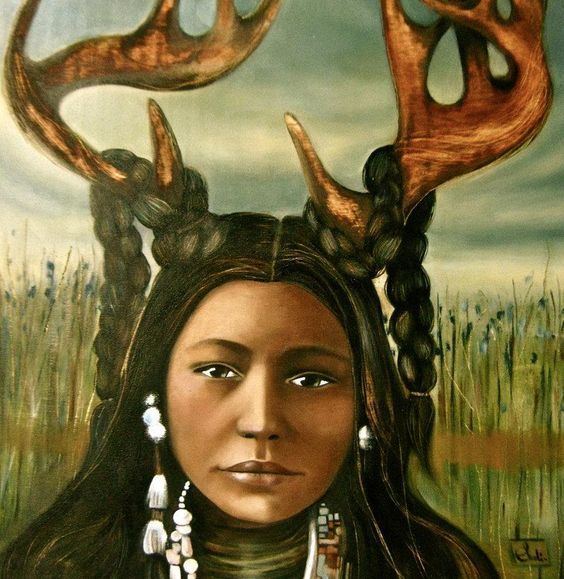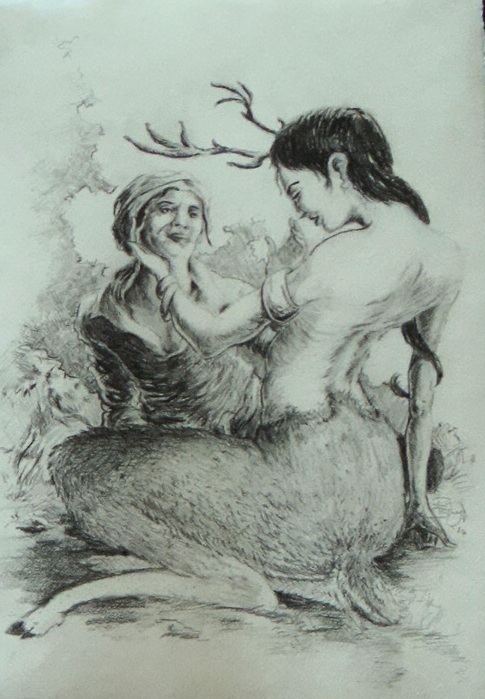 | ||
Similar Ababinili, Altamaha ha, Amala (mythology) | ||
The Deer Woman, sometimes known as the Deer Lady, is a spirit in various forms of Native American mythology that is primarily associated with fertility and love. Though primarily shown as a benign spirit, she is also shown to lure promiscuous men to their death. She appears as either a beautiful young woman or deer.
Contents
- Deer Women
- In Native American folklore
- Meaning in Deer Woman stories
- Similar creatures
- In pop culture
- References

Deer Women
In Native American folklore

Deer Woman stories are found in many Native American tribes, told to young children or by young adults and prepubescents in tribes like the Sioux, Ojibwe, Ponca, the Omaha people, Cherokee, Muscogee, Seminole, Choctaw, the Otoe tribe, the Pawnee people, and the Iroquois - and those are only the few that have documented Deer Woman sightings.
In Ojibwe tradition, she can be banished through the use of chanting and tobacco. Others claim that the spell she casts can be broken if one looks at her cloven hooves.
Other stories and traditions describe the sighting of Deer Woman as a sign of personal transformation or as a warning. Deer Woman is also said to be fond of dancing and will sometimes join a communal dance unnoticed, leaving only when the drum beating ceases.
Meaning in Deer Woman stories
Deer Woman stories are meant to instruct men to avoid and to caution woman against promiscuity. When the Deer Woman is the villain, the victim of her spell and violence is an unmarried man or an unfaithful husband. In Paula Gunn-Allen's short story "Deer Woman", the Deer Women are not the villain; instead, they are gangways for the true conflict of traditional values versus the sexism and misogyny that came from colonization. In her essay "Sacred Hoop", Gunn-Allen asserts that these Deer Woman are not malicious, but highly cultured and revered beings. By punishing sexual behaviors that Gunn-Allen claims are caused by colonial patriarchy, the Deer Woman are "rebuilding the way of the mothers and grandmothers, the sacred way of women" that was the norm of tribal gynocracy prior to colonization.
Similar creatures
The Deer Woman show characteristics and traits of both sirens and succubi. The siren, according to the Theoi Project, are monstrous sea nymphs that lure men to their deaths with their song. Succubi, as defined by the Merriam-Webster dictionary, are "demons who take female form who have sexual intercourse with men in their sleep"; constant contact with a succubus can result in failing health or death for the man. Deer woman lure men with their beauty and magic, like the sirens, and then sleep with and kill men like succubi. Countless female spirits world wide have similar characteristics.
Fiura, of the Chiloè region of Chilè, causes deformation in anyone who looks upon her and will cast spells to confuse young woodsmen into sleeping with her. La Patasola, literally "one footed", is a shape-shifter from the Antoquia region of Colombia who takes the form of a beautiful woman to lure men with her cries of fear; when the men (who are often causing harm in one way or another to the rain forest) come to her, she drops her beautiful mask and slaughters them in an effort to protect the forest.
La Tunda, another nature spirit from Colombia, lures people of all walks of life to them with their song and then drains them of blood; La Tunda can also shape-shift, but she will always have a single leg of a molinillo that she is very careful to hide.
The Brazilian Iara are beautiful warrior mermaids who - when found by a man - will charm him with her voice and beauty and either drown him or turn him into something like her and make him her lover. La Llorona ("the crier"), who is found in Mexico and the Southwest United States, is a female ghost who will kidnap the souls of children - effectively killing them - and who's cries bring irrevocable sorrow and who the sighting of spells death for someone within the week.
While all these spirits will lure away and/or hurt others, they also have physical deformity in common. The Deer Woman has hooves. Sirens are bird from the chest down. Succubi were originally portrayed as hideous and demonic. The Fiura is described as being absolutely hideous, and La Patasola has no right leg from the pelvis down and her right breast is fused to her arm. La Tunda has a whisk for a leg, and the Iara are half Brazilian guppy. La Llorona is beautiful when viewed from behind, but she is depicted as having the face of a horse
